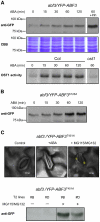The Arabidopsis ABA-activated kinase OST1 phosphorylates the bZIP transcription factor ABF3 and creates a 14-3-3 binding site involved in its turnover
- PMID: 21085673
- PMCID: PMC2978106
- DOI: 10.1371/journal.pone.0013935
The Arabidopsis ABA-activated kinase OST1 phosphorylates the bZIP transcription factor ABF3 and creates a 14-3-3 binding site involved in its turnover
Abstract
Background: Genetic evidence in Arabidopsis thaliana indicates that members of the Snf1-Related Kinases 2 family (SnRK2) are essential in mediating various stress-adaptive responses. Recent reports have indeed shown that one particular member, Open Stomata (OST)1, whose kinase activity is stimulated by the stress hormone abscisic acid (ABA), is a direct target of negative regulation by the core ABA co-receptor complex composed of PYR/PYL/RCAR and clade A Protein Phosphatase 2C (PP2C) proteins.
Methodology/principal findings: Here, the substrate preference of OST1 was interrogated at a genome-wide scale. We phosphorylated in vitro a bank of semi-degenerate peptides designed to assess the relative phosphorylation efficiency on a positionally fixed serine or threonine caused by systematic changes in the flanking amino acid sequence. Our results designate the ABA-responsive-element Binding Factor 3 (ABF3), which controls part of the ABA-regulated transcriptome, as a genuine OST1 substrate. Bimolecular Fluorescence Complementation experiments indicate that ABF3 interacts directly with OST1 in the nuclei of living plant cells. In vitro, OST1 phosphorylates ABF3 on multiple LXRXXpS/T preferred motifs including T451 located in the midst of a conserved 14-3-3 binding site. Using an antibody sensitive to the phosphorylated state of the preferred motif, we further show that ABF3 is phosphorylated on at least one such motif in response to ABA in vivo and that phospho-T451 is important for stabilization of ABF3.
Conclusions/significance: All together, our results suggest that OST1 phosphorylates ABF3 in vivo on T451 to create a 14-3-3 binding motif. In a wider physiological context, we propose that the long term responses to ABA that require sustained gene expression is, in part, mediated by the stabilization of ABFs driven by ABA-activated SnRK2s.
Conflict of interest statement
Figures






Similar articles
-
PYR/PYL/RCAR family members are major in-vivo ABI1 protein phosphatase 2C-interacting proteins in Arabidopsis.Plant J. 2010 Jan;61(2):290-9. doi: 10.1111/j.1365-313X.2009.04054.x. Epub 2009 Oct 26. Plant J. 2010. PMID: 19874541 Free PMC article.
-
Four Arabidopsis AREB/ABF transcription factors function predominantly in gene expression downstream of SnRK2 kinases in abscisic acid signalling in response to osmotic stress.Plant Cell Environ. 2015 Jan;38(1):35-49. doi: 10.1111/pce.12351. Epub 2014 May 22. Plant Cell Environ. 2015. PMID: 24738645 Free PMC article.
-
A link between magnesium-chelatase H subunit and sucrose nonfermenting 1 (SNF1)-related protein kinase SnRK2.6/OST1 in Arabidopsis guard cell signalling in response to abscisic acid.J Exp Bot. 2015 Oct;66(20):6355-69. doi: 10.1093/jxb/erv341. Epub 2015 Jul 13. J Exp Bot. 2015. PMID: 26175350 Free PMC article.
-
Updates on the Role of ABSCISIC ACID INSENSITIVE 5 (ABI5) and ABSCISIC ACID-RESPONSIVE ELEMENT BINDING FACTORs (ABFs) in ABA Signaling in Different Developmental Stages in Plants.Cells. 2021 Aug 5;10(8):1996. doi: 10.3390/cells10081996. Cells. 2021. PMID: 34440762 Free PMC article. Review.
-
A brand new START: abscisic acid perception and transduction in the guard cell.Sci Signal. 2011 Nov 29;4(201):re4. doi: 10.1126/scisignal.2002164. Sci Signal. 2011. PMID: 22126965 Review.
Cited by
-
ABA and the ubiquitin E3 ligase KEEP ON GOING affect proteolysis of the Arabidopsis thaliana transcription factors ABF1 and ABF3.Plant J. 2013 Sep;75(6):965-76. doi: 10.1111/tpj.12259. Epub 2013 Jul 19. Plant J. 2013. PMID: 23742014 Free PMC article.
-
Post-translational Modifications of bZIP Transcription Factors in Abscisic Acid Signaling and Drought Responses.Curr Genomics. 2021 Jan;22(1):4-15. doi: 10.2174/1389202921999201130112116. Curr Genomics. 2021. PMID: 34045920 Free PMC article. Review.
-
Plant 14-3-3 proteins as spiders in a web of phosphorylation.Protoplasma. 2013 Apr;250(2):425-40. doi: 10.1007/s00709-012-0437-z. Epub 2012 Aug 29. Protoplasma. 2013. PMID: 22926776 Review.
-
14-3-3 proteins contribute to leaf and root development via brassinosteroid insensitive 1 in Arabidopsis thaliana.Genes Genomics. 2020 Mar;42(3):347-354. doi: 10.1007/s13258-019-00909-4. Epub 2020 Jan 4. Genes Genomics. 2020. PMID: 31902106
-
A 14-3-3 Family Protein from Wild Soybean (Glycine Soja) Regulates ABA Sensitivity in Arabidopsis.PLoS One. 2015 Dec 30;10(12):e0146163. doi: 10.1371/journal.pone.0146163. eCollection 2015. PLoS One. 2015. PMID: 26717241 Free PMC article.
References
-
- Ton J, Flors V, Mauch-Mani B. The multifaceted role of ABA in disease resistance. Trends Plant Sci. 2009;14:310–317. - PubMed
-
- Wasilewska A, Vlad F, Sirichandra C, Redko Y, Jammes F, et al. An update on abscisic acid signaling in plants and more. Molecular Plant. 2008;1:198–217. - PubMed
-
- Yamaguchi-Shinozaki K, Shinozaki K. Transcriptional regulatory networks in cellular responses and tolerance to dehydration and cold stresses. Annu Rev Plant Biol. 2006;57:781–803. - PubMed
Publication types
MeSH terms
Substances
Grants and funding
LinkOut - more resources
Full Text Sources
Other Literature Sources
Molecular Biology Databases
Research Materials

